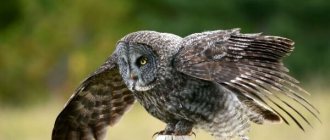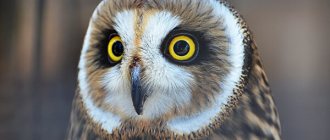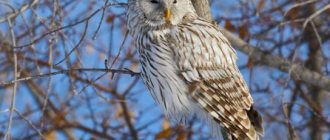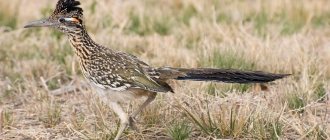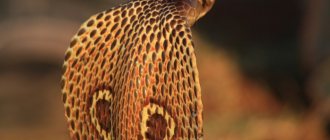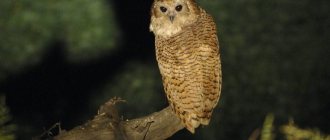- Wild animals
- >>
- Birds
The tawny owl is a nocturnal bird of prey from the owl family. These are dangerous hunters with excellent hearing, exterminating rodents and other small animals. They can live either deep in the forest or right in the city, settling in an abandoned building. They are usually not dangerous to people unless they are protecting a nest.
Origin of the species and description
Photo: Tawny Owl
There are several main versions of the origin of birds. According to one of them, Archeopteryx is considered the oldest species, and they appeared in the Jurassic period and were related to the maniraptor dinosaurs. According to another hypothesis, they arose earlier, back in the Triassic period, and descended from archosaurs, and the first bird was Protoavis.
But before the appearance of owls, in particular owls, it was still far away - it is assumed that their ancestors were arboreal climbing birds related to Coraciiformes, and the first owls appeared at the end of the Paleocene.
Video: Tawny Owl
The oldest owl known to science is the fossil Ogygoptynx wetmorei. The genus to which she belonged became completely extinct, like the other owls that appeared first. The oldest owls found by paleoantologists date back to the Lower Pleistocene - so they lived about 600,000 years ago, which is very short by evolutionary standards.
It is assumed that the oldest owls were active during the day and fed mainly on insects, perhaps specializing in carrion. Over time, they switched to a nocturnal lifestyle - this was largely due to the fact that the largest insects are active at night, and owls adapted to their rhythm of life.
Moreover, at night they had much less competitors. Over time, their priorities changed, and they began to feed primarily on rodents, although many modern owls, including owls, sometimes eat insects. They also developed their own hunting style, based not on flight speed, like daytime birds, but on secretly stalking prey and a sudden attack.
The scientific description of owls was made by Carl Linnaeus in 1758, he also gave the genus the name Strix, and also described many individual species. This process continued throughout the 18th-20th centuries, and the desert owl was identified only in 2015; it was previously considered a subspecies of the pallid owl.
Appearance and features
Photo: Gray owl
The body length of a mature individual can vary from 30 to 70 centimeters depending on the species - some are quite small, while others are quite impressive in size for birds. The tawny owl is one of the smallest - its size is usually 35-40 centimeters, and its weight does not exceed 600-700 grams.
The tawny owl does not have feathered “ears”; this is an important feature by which it can be distinguished externally from many other owls. Moreover, it has large ear openings covered with a leather fold. The beak is located high and distinctly flattened on the sides.
The plumage can range from gray to distinctly red, often with dark brown spots. The eyes are dark, yellow in some species (for example, the tawny owl). The plumage is soft, owls are very fluffy, due to which they look much larger than they actually are.
Since the owl hunts in the dark, it relies primarily on its hearing, fortunately, it is excellent. The structure of the wings does not allow it to fly as fast as daytime predators like falcons and hawks, or to perform the same complex somersaults in the air.
Interesting fact: Sometimes people pick up tawny owl chicks that have fallen from the nest. This should only be done if they are injured, and then not without fear - their parents may suddenly appear. A healthy tawny owl chick will be able to return to the nest on its own.
FOOD AND HUNTING
The tawny owl hunts exclusively at night. She observes the surroundings from high-lying objects - rooftops or treetops. Having noticed its prey, the owl attacks it quietly and with lightning speed. The coloring of the owl's feathers is very elegant, and the feathers in the flight parts, which have a crest, are well adapted for flight. The flight of this bird is quiet and silent. She has excellent hearing, which helps her recognize prey even at night, when her very acute vision may not be enough. In forests, the gray owl hunts small animals, birds and insects; near human settlements, it hunts mainly birds.
Where does the tawny owl live?
Photo: Great Gray Owl
The habitat depends on the species, sometimes they may not even overlap.
Eg:
- The Chaco owl lives in the Gran Chaco in South America, as well as in the surrounding areas;
- The Great Tawny Owl prefers to live in Egypt, Syria, Israel and Saudi Arabia;
- black-and-white and spotted tsikkabs live in Central America, Venezuela, Colombia, Ecuador;
- gray owl - in the taiga from the Murmansk region to Primorye.
Besides these, there are many other types. One of them can be found almost everywhere: from the south of Argentina to the equator and the Arctic Circle. At the same time, they are sedentary, that is, they live in the same place where they were born. If a tawny owl moves away from its birthplace, it is only because conditions there have worsened, and usually not far away.
They live in deciduous, coniferous or mixed forests, but it cannot be said that they are very demanding of their environment, and sometimes they can even settle right in cities, choosing trees in the park or unused attics - they are attracted by the fact that it is much easier to get food in the city, than in the forest.
Nevertheless, most of the owls are not tempted by this and live in forests; for nests they choose hollows in old trees or simply settle in the abandoned nest of another bird. They don’t live in the mountains - they don’t climb higher than 2,000 meters, and they can rarely be seen at these altitudes.
They choose places to live close to clearings or forest edges - they are best able to hunt in open space, and not in a dense forest, where it is far from so convenient to do so.
Habitat
The population of this owl species is widespread in Asia and Europe. Sometimes the tawny owl is found in northern Africa and in the American latitudes. In the Russian Federation you can find the Great Great Gray Owl, the Long-tailed Owl and the Gray Owl. The tawny owl is widespread in Europe. The habitat of these birds is located near clearings and forest edges. As a rule, tawny owls build their nests in tree hollows or between stones.
What does a tawny owl eat?
Photo: Tawny Owl
The basis of the tawny owl’s “menu” is:
- rodents - mice, squirrels, etc.;
- lizards;
- frogs;
- small and medium-sized birds, such as black grouse or hazel grouse;
- insects;
- arthropods;
- fish.
Depending on the species and habitat, there are nuances - for example, tropical owls can feed on large spiders. Most species hunt at night, although there are also daytime hunters - for example, the great gray owl.
As a rule, these predators fly out after prey in the dark, listen carefully and catch every sound, even quiet and distant rustles do not escape them. Tawny owls roughly determine the size of prey by sound and, if it is suitable, that is, small enough, they go into ambush so as not to frighten off the potential victim with the noise of their wings.
They then wait for the moment when she is most defenseless and reach her in one quick burst, using almost exclusively their hearing to determine her exact location. Such a throw at prey is usually very fast, so that the prey does not even have time to come to its senses before it finds itself in the claws of a tawny owl - it covers 5-8 meters in just a few moments.
These birds are very effective at exterminating rodents, and therefore, if a tawny owl settles near cultivated lands, this can only benefit them. They prefer to eat rodents, and look for other prey only if they cannot be caught; they can destroy 150-200 mice in a month.
But for those in the north who hunt for skins, they do a lot of harm - they not only destroy valuable fur-bearing animals, but also often eat those already caught in a trap, spoiling the skins - after all, there is no need to catch them.
Features of character and lifestyle
Photo: Tawny Owl
Tawny owls hunt in the dark, but not necessarily at night - they often do this in the evening twilight or early morning before dawn. In this regard, different species have their own preferences. Some owls even hunt during the day, and even those that are usually active at night can sometimes do this during the day, especially in winter.
The owl usually has quite a lot of time free from hunting and sleep; it spends it in its nest or nearby, usually not showing much activity and just resting. At the same time, she is always on the alert and ready to attack even when she is resting.
If a tawny owl notices something suspicious, it silently observes, trying not to give anything away. If she decides that the danger is serious, she flies away just as silently, or attacks if she needs to protect the chicks. Tawny owls make almost no sounds at all, but at sunset they sometimes start a roll call.
Then they begin to prepare for the hunt: they can fly a little in advance, usually low above the ground - during such flights they look out for future victims. Such flights become more frequent if there is little prey, and when there is an abundance of it, the bird usually does not worry and does not conduct such “reconnaissance.” If there is a constant shortage of prey around her home, she may fly to another place.
The lifespan of owls is determined by their size - the larger these birds, the longer they live on average. Tawny owls, accordingly, have a short lifespan, usually about 5 years, while in larger species it can reach up to 7-8 years.
Interesting fact: Although tawny owls are usually sedentary, sometimes large numbers of individuals can fly long distances at once. In particular, they can settle in areas where this species was not previously represented at all, thus expanding their range. Young birds take part in such mass migrations when they grow up in autumn.
Interesting facts about the bird
Owls have very fine hearing and are able to hear the slightest rustling of grass. Gray Owls are able to turn their heads 270° due to the unique anatomical structure of the cervical vertebrae.
Tawny owls, contrary to popular belief, see perfectly during the day and are able to discern objects or danger at a great distance. In Finland and the Leningrad region, owls hunt during the white nights. Owls see in black and white.
During the mating season, males become very talkative. When courting a female, the male may make shrill or dull sounds that are similar to voices. By hooting, owls notify competitors that the territory is occupied and attract females. In the old days, superstitious people believed that these were the voices of ghosts.
Social structure and reproduction
Photo: Tawny owl chicks
Tawny owls often live in pairs; they can also settle in larger groups, but at a relative distance from each other, because otherwise there will not be enough prey for everyone. However, this depends on the type of bird: there are more aggressive owls that do not tolerate the proximity of other owls, there are less so - sometimes they even live in the same tree with birds of prey of other species.
Small birds, for example, passerines, react to a flying owl with alarming cries, warning their relatives of danger. It usually does not compete with large predators, since they hunt during the day, but conflicts are still possible.
Some species are very territorial and tend to defend their “domains”. If someone is in them, the bird screams and in every possible way demonstrates its readiness to attack, but does not attack immediately and gives time to leave. If the “intruder” does not take advantage of this opportunity, he proceeds to active actions - cats, dogs, foxes, and people too have been attacked by owls more than once.
Pairs are formed for more than one year - tawny owls can spend their entire lives together. An approximately equal ratio of males and females at sexual maturity promotes monogamy. But in some species, bigamy is also common - sometimes two females share one male, and they can have either one nest or two not far from each other.
During reproduction there are pronounced species characteristics. Thus, the great gray owl, unlike other species, does not build nests at all; instead, it settles in the abandoned nests of other birds of suitable size. They usually make nests in hollows, sometimes in the attics of abandoned houses.
The beginning of the mating season is determined by the climate in which the tawny owl lives. In cold climates, it can occur as soon as winter ends, and by the middle or end of spring the chicks are already beginning an independent life. In the tropics it may be late summer or early autumn. Among the rituals, sound signals can be distinguished - at the onset of the mating season, the forest is filled with the drawn-out hoots of males and short responses of females.
They usually lay 2 to 4 eggs, after which they diligently incubate them until the chicks hatch - this usually takes 4 weeks. Sometimes males also participate in incubation, but not in all species. They also protect the nest from attacks by predators and bring food to the females, who cannot tear themselves away from incubating eggs for hunting.
Newborn chicks have white down, then gradually they are covered with dark stripes. By one and a half months they can already fly a little, and are fully feathered by 3-4. Almost immediately after this, they leave the nest and begin to live independently, although in some species young tawny owls can remain with their parents for up to 6-7 months.
Natural enemies of owls
Photo: Gray owl
There are no specialized enemies - that is, no one intentionally hunts them. But this does not mean that owls are not in danger - in fact, there are quite a lot of them. In addition to deadly diseases and lack of nutrition, which are very common causes of their death, large birds of prey can also be dangerous.
Tawny owls are primarily threatened by eagles, golden eagles and hawks. Even though they are about the same size, these birds have much more advanced wings, giving them an advantage, and they are also more aggressive and adapted to fight other birds.
Although the tawny owl is capable of standing up for itself, especially if it had to defend the nest - in this case, it fights with any aggressor, regardless of the odds, even if a bear decides to feast on the eggs. Therefore, it is better not to approach the nest - an enraged bird can even lose an eye.
Danger can also come from larger owls, primarily eagle owls, as well as from fellow tribesmen - usually owls do not conflict with each other, but exceptions do occur. Most often, they are associated with overpopulation of the area by owls, due to which conflicts arise between them for food.
No less often, the cause of death of a tawny owl is a person: they are shot by hunters, they fall into traps set for rodents, or they are poisoned due to the fight against the same rodents with the help of zinc phosphide.
GRAY OWL HUNTING TECHNIQUES
The gray owl is perfectly adapted to catching small animals. She has very good eyesight and hearing, and nothing escapes her attention. Silently and unexpectedly, it flies up to the victim. This is possible thanks to the soft plumage and jagged ridges on the front flight part of the wings.
— Habitat of the gray owl
WHERE DOES IT LIVE?
Throughout Europe, except for Northern Scandinavia, small areas of North Africa, Ukraine, western Russia, Afghanistan, China.
PROTECTION AND PRESERVATION
In most areas where the common owl lives, it is not in danger of extinction. It preys on small owls, such as scops owls, owls, and scops owls, and reduces their populations.
